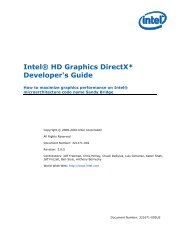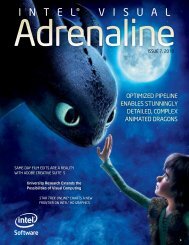Intel ® Visual
Intel ® Visual
Intel ® Visual
You also want an ePaper? Increase the reach of your titles
YUMPU automatically turns print PDFs into web optimized ePapers that Google loves.
the guardian project<br />
knowledge of each Guardian’s powers to<br />
know which Guardians to use in each battle.<br />
Just like Mike, they’ll have to engender<br />
the undying support from the Guardians<br />
and make quick knowledgeable decisions<br />
as to how they are best used in battle.”<br />
Krygowski said the main challenge in this<br />
cross-platform launch has been on the<br />
game side. The pipeline is thinner on the<br />
game engine side, so assets and models<br />
need to respect texture resolutions, rig<br />
requirements, mapping, and megabyte<br />
sizes. He said this is completely “doable,”<br />
however forethought and pre-production<br />
must be strong to address potential issues<br />
regarding these details.<br />
The <strong>Intel</strong> Connection<br />
As Epic continues to expand its Unreal Engine 3<br />
technology, it’s opening up more doors into<br />
Hollywood. Collaboration between <strong>Intel</strong> and<br />
Epic goes back more than 10 years to when<br />
the two companies pioneered landmark-setting<br />
uses of MMX technology. Today, performance<br />
improvements through multi-threading are a<br />
key focus. “<strong>Intel</strong><strong>®</strong> Threading Building Blocks 2.1<br />
allowed us to easily remove allocation-related<br />
multi-threading bottlenecks on 64-bit operating<br />
systems,” said Michael Capps, president of Epic<br />
Games. “We are pleased to share the benefits<br />
of <strong>Intel</strong>’s memory allocator with Unreal Engine<br />
3 licensees, as well.” Through <strong>Intel</strong><strong>®</strong> Software<br />
Development Products recently available via the<br />
Epic Integrated Partner Program, Unreal Engine<br />
licensees have access to additional resources for<br />
multi-threading and performance optimization of<br />
their games.<br />
Mark McNabb, <strong>Intel</strong> application engineer, said<br />
that Epic Games’ recent high-end “Samaritan”<br />
GDC 2011 demonstration running on a high-end<br />
PC looks significantly better than anything<br />
currently available on gaming consoles. “That<br />
demo uses newer DX11 features that aren’t<br />
available on the current consoles, but the newer<br />
PCs support DX11,” said McNabb. “The demo<br />
is intended to showcase the high-end GPU.<br />
But, systems with high-end GPUs tend to also<br />
contain high-end CPUs.”<br />
Epic has capitalized on <strong>Intel</strong> engineering support<br />
during the design of Unreal Engine 3, focusing<br />
in particular on multi-core optimization and the<br />
threading of 3D operations to take full advantage<br />
of parallelization. The key optimization work<br />
divided the main game thread into two individual<br />
threads: one devoted to rendering and the<br />
other to all remaining high-level operations. The<br />
technique, called a “render split,” removes the<br />
processing burden of rendering from the main<br />
game loop. Regardless of what is going on in the<br />
game loop, rendering calls run in parallel, resulting<br />
in a substantial overall performance boost.<br />
It’s this type of advanced power that has allowed<br />
real-time feedback for Hollywood companies<br />
such as HOM to implement this game engine<br />
technology into all of its production work. Video<br />
games, film, and television will benefit from these<br />
advances as the lines continue to blur between<br />
interactive and traditional entertainment.<br />
The Future of<br />
Entertainment<br />
HOM has already integrated Unreal Engine 3<br />
technology into its system, intending to employ<br />
the game project on both video game and<br />
Hollywood projects. Krygowski said that while<br />
traditional TV entertainment still exists, it is fast<br />
becoming the exception and not the rule. He said<br />
the game engine has the ability to help push<br />
the envelope of media by allowing creators to<br />
build a single set of assets for a variety of media,<br />
allowing for real-world environments, assets, and<br />
characters to traverse multiple uses, resolutions,<br />
and intentions.<br />
“With the evolution of DirectX* technology and<br />
rendering, hardware game-engine technology is<br />
becoming more viable,” said Menache. “The trend<br />
is that people like us will be building the tools,<br />
and soon enough software like the UDK (Unreal<br />
Development Kit) will be aimed more toward<br />
creating linear content, as well.”<br />
In Hollywood it all comes down to dollars and cents.<br />
And Chargin believes that video game technology<br />
will become a mainstay in Hollywood because of<br />
economics. He said the Unreal Engine allows his<br />
team to produce a higher quality product in a<br />
fraction of the time of traditional CG animation.<br />
Creatives can bank on this, moving forward. And<br />
the implications for the game industry are also<br />
huge, given that the sharing of assets built in the<br />
same engine will allow for more immersive<br />
experiences. But perhaps more importantly, it will<br />
blur the lines between interactive and linear<br />
entertainment—just as The Guardian Project and<br />
its cast of 30 superheroes is doing. •<br />
About the Author<br />
John Gaudiosi has spent nearly 20 years covering<br />
the video game industry. He also co-founded the<br />
world’s first syndicated video game and<br />
technology network, www.Gamerlive.tv.<br />
intel visual adrenaline no. 10, 2011 6













